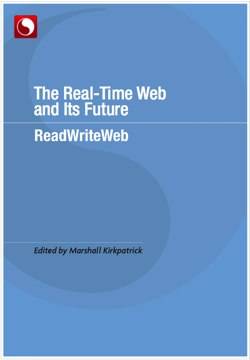We’re excited to announce that our latest premium research report will be available for download on Monday! Titled The Real-Time Web and Its Future, the report is a broad and deep look at the emerging world of real-time technology on the web. Based on 50 interviews with companies, engineers and executives building or leveraging real-time technology – the subtitle of this report could very well be “Real-Time, Beyond Twitter and Facebook.”

Social networks, infrastructure providers, media companies, non-profits and financial services companies were all interviewed and will all find this report useful to quickly develop a sophisticated understanding of this important trend on the web. Large portions of the web will be operating in real-time and this report will provide you with an important competitive advantage. You can pre-order the report at a $100 discount here; check out the Table of Contents (PDF) and a sample chapter (PDF) below.
There is so much work being done around push delivery of messages – messages between people, between websites and people and between machines and machines – that it’s impossible to capture the whole market.
What we’ve done is develop in-depth case studies of 10 companies that are illustrative of general trends or have wildly innovative strategies. We’ve profiled twenty four key people to watch in order to understand the future of real time. We’ve done overviews of three of the biggest sectors in this market – search, stream readers and filtering/text analysis. And we offer five visualizations to help you understand the issues and strategies.
This report captures the wisdom of thousands of hours of work with real-time technology by people breaking new ground – then it was distilled down through hundreds of hours of interviews, research and writing by ReadWriteWeb staff and hundreds of Real-Time Summit attendee conversations. Now you can purchase the report and get an in-depth understanding of this emerging trend in just a few hours of reading and for a bargain price of $200 by pre-order, or $300 next week.
Pre-order today and you’ll receive a link to download the 60+ page PDF on Monday, November 30th.
For your perusing pleasure we offer today the Table of Contents and one full sample chapter for download. Or, check out this excerpt from that sample chapter below.
Ted Roden Brings the Real-Time Web to the NY Times and EnjoysThings

By day, Ted Roden works at the very top floor of the New York Times building, in the R&D department. The Times has a great team of engineers; they do cutting edge work in APIs, data visualization and computer assisted reporting. Roden does work with real-time data at his day job, but he gets full creative freedom when working a side-project called EnjoysThings.
The primary contributions Ted Roden makes to understanding the real-time web include articulating:
We had a conversation with Roden about what happened after he added a real-time feed to EnjoysThings; he articulates well some of the biggest advantages of a real-time infrastructure.
- the material benefits of going real time
- the importance of user experience
- the changing landscape in analytics and advertising
EnjoysThings is a visual bookmarking site, like Delicious for images and other media. Even text snippets bookmarked are highlighted visually. User experience is a key consideration in all the site’s developments and the service is a lot of fun to use.
This summer Roden added a premium subscription option to the site, called Joy accounts. Joy accounts cost $20 per year for access to all the current and forthcoming premium features, or users can pay $5 for a single premium feature like disabling ads on the site or being able to view NSFW content.
One of the features Joy account holders get is access to a real-time view of new content
shared. That real-time stream can be viewed in any browser but may be best served up via a Firefox sidebar. A real-time feed as up-sold value add? That’s remarkable and Roden says the response has been positive.
The sidebar is simple but compelling. New content is pushed live into the side of the
browser as soon as it’s shared on the site, including images. At first Roden said he used AJAX set to poll his site every few seconds. Then he switched to a Comet implementation. He says he’s using the open source infrastructure Tornado, from Facebook, for his real-time prototypes at the Times.
EnjoysThings is still very small but the implications of adding real-time to this site could
likely be incurred by sites of any size.
1. INCREASED TIME ON SITE
“People leave it open all day long,” Roden said of the sidebar. “Time-on-site has seen a
huge increase. It’s like when the new content comes in on the Facebook Live Feed, if you know it’s about to pop in 5 seconds you’ll stick around.”
There are a number of different factors that are making time-on-site an increasingly
important metric on the web, compared to pageviews. Increased consumption of video
is the best known, but as real-time streams of aggregated content become increasingly
common, increased time-on-site will be an important measurement of how successful an implementation is.
2. DECREASED SERVER COSTS
After implementing real-time infrastructure, Roden reports that “my site runs a lot more
smoothly, I’ll probably move the whole site to that technology because deep down it’s
much easier on the database for me.”
“I used to get hit by Stumbleupon and [the site] would start to crawl. Then I changed to some of this real time stuff and I’ve reduced the number of servers. Instead of the users sitting on the page and refreshing, I push it out to them. My EC2 bill has gone way down.” Roden’s experience compliments the story that Google’s Brad Fitzpatrick told us about using PubSubHubbub push feeds to deliver shared items in Google Reader to FriendFeed. Changing from polling to real-time push cut traffic between the two sites by 85%. Likewise, magazine-style feed reader Feedly says that the part of its service that now consumes PubSubHubbub from Google Reader has seen a 72% reduction in bandwidth.
…(continued) To read the rest of this sample chapter, see the PDF download above. Please see also the Table of Contents and pre-order now to get a great discount on the forthcoming report!










